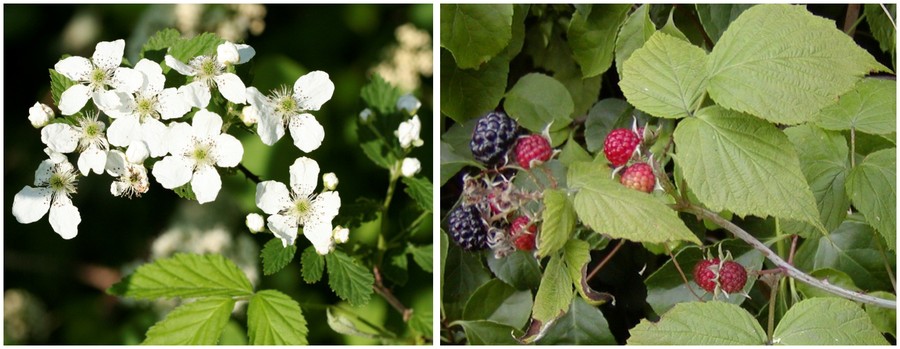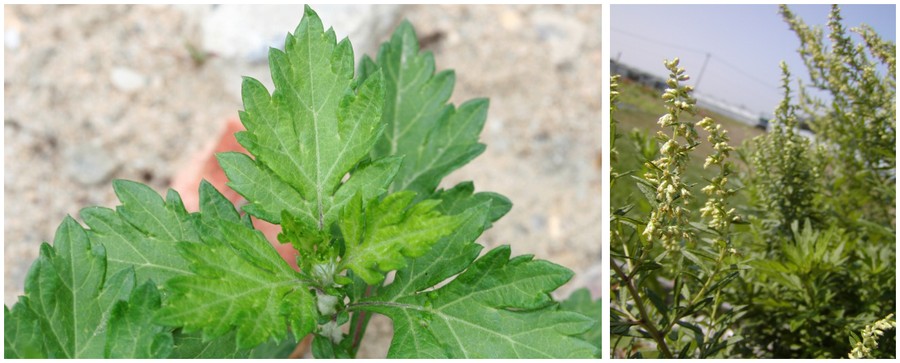Tips for Control of Kudzu
Goat and pig grazing and human mowing deplete its food stores and diminish its vigor, but fierce taproots require powerful plant killers –there are some organic ones to use. Apply weed-killer to cut stems in order to allow toxins to drift down into roots. Do this repeatedly, over several years. This may deter it slightly, after all, a 100 lb. root mass, 10’ deep, takes more than a little poison to halt its spread. Pull out its entire root when it’s young. Keep at it, even if it takes several years.
Weeds often resemble what they grow next to. This gives weeds time to grow fast and evade notice.
Watch a Multiflora rose, Rosa multiflora or a Blackberry bramble, Rubus argutus, blend in with your climbing and rambling well-bred Roses before any of them bloom. If you leave either the Multiflora rose or the Blackberry bramble alone, it will shade the hybrid Rose into ill-health and take over that same spot.
Both of these weedy climbers have long thorny woody stalks and lots of blooms—usually white, small and open faced (singles, in Rose-speak)—that resemble Rambling roses. Both form berries later in the season like Rambling roses do. The Multiflora rose develops red “hips” just like many Rambling and Rugosa roses, while the Blackberry bramble differentiates itself in fruit shape and color as it forms black berries, which also taste better, to me, than Rose hips. While both of these weedy invaders initially look and bloom like certain cultivated Roses, and hide in plain sight, they grow more vigorously and faster, need no fertilizer, penetrate compacted, poor soils, spread with little intervention and climb vigorously with no need for gardener assistance. Both of these weeds bloom too briefly, especially compared with cultivated Roses which are bred to repeat bloom over a long season.

Left: Multiflora rose in full, glorious bloom Right: Multiflora rose with spent flowers, too soon thereafter

Left: Blackberry bramble flowers before berrying Right: Blackberry bramble after flowers ripen into berries
But with the profusion of flowers that forms on Multiflora roses, and the profusion of black berries the Bramble provides, you may not see them as weedy at all. If you enjoy them at the edge of your woodland, however briefly, as the gardener in the most floriferous picture does, leave them be and mow off their baby offspring to keep them in control.
Ironically the Multiflora rose, like Kudzu, was planted by local governments to build up the soil eroded by new road construction. Multiflora roses and Blackberry brambles compete best in hardpan soil with low calcium. Since as we build highways, soil becomes compacted and airless and calcium depletes rapidly, it made sense to use Multiflora roses to improve erosion control. Now they continue to spread even as the soils they occupy become richer. They beat the other plants to the buffet table and, once fed, will not relinquish their territory. The old roads now still have swaths of impassable brambles from what started out with the best of intentions.
The young foliage of Mugwort, Artemisia vulgaris, closely resembles the young foliage of hybridized Mums. It easily fools the gardener who may assume his Mum overwintered when in fact Mugwort eased it out of existence. I know. It happened to me in my garden. Both are Composite, Asteraceae, family members and their lower young leaves do look similar. When Mugwort grows up it changes leaf shape and has tall scraggly flowers, Mums stay neat and have large voluptuous flowers. Then it’s too late: Mugwort speeds with greed.
“It grows through asphalt with the greatest of ease,
this daring strong herb with the talent to seize,
It forms graceful foliage, and pollen to sneeze,
and my garden it’s purloined away.”
I sang this to the melody of the “Daring Young Man on the Flying Trapeze” when the Mugworts invaded my yard. My professor of herbs in Master Gardening school would, in jest I hope, curse disruptive students with, “may your garden be infested with Mugwort”, so gardener, beware! White undersides of leaves, covered in softly fuzzy hairs, distinguish its much-lobed young leaves from the young leaves of Mums, which look and smell like it. In the blitz of prime garden season, the difference easily evades notice and offers Mugwort the early mover and speedy grower advantage.

Left: Mugwort leaves close up—young plants resemble Mums Right: Mugwort looks weedy when it grows up
Unlike Mums, Mugwort can regenerate new plants from its rhizomes and seeds quickly. Mugwort grows thick rhizomes up to 6’ long, that anchor and nourish themselves with additional thin rootlets. If broken, rhizomes and rootlets start new clones. With its sprawling root system, a single Mugwort erupts like a wart to mug your cultivars. It sprouts in unwanted and tough places. Like many weeds it grows in low humus soils with very low calcium levels and tolerates hard and airless areas. Some observers insist that over the years, its roots travel under asphalt from North- to South-bound and East- to West-bound lanes of wide highways. In cold climates, roots lead its reproductive efforts better than seeds do, though it also seeds prodigiously. Mugwort can spread from the new well-rooted plants, aided and abetted by early disguise, abundant seeds and sneeze-worthy pollen. Yet it was intentionally brought to the U.S. as food, pharmaceutical, and magical herb.
Some weeds produce seeds prolifically
like the weedy plants of the Mustard or Brassica family. Prodigious weed seed production—if left alone—creates peril rapidly in the garden. The soil itself contains millions of weed seeds in the soil “seed bank”. All the generations of plants that inhabited the earth long before us, set seed and left behind genetic memories of each plant in a well-evolved and durable package. Studies of soil samples reveal the astounding number and types of seeds left behind. As we humans tread upon or break the soil, we expose these slumbering, tiny, potential giants to air, water, and sunlight and signal them to wake up and take over the Roses.